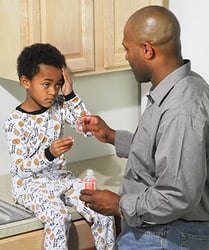How are headaches treated?
- Headaches are treated in different ways. You and your child may be asked to keep a headache calendar. It helps track how often and how painful the headaches are and to look for patterns. It can be very helpful for treating your child’s headaches. Your health care provider can teach you how to use a calendar.
- If things that can bring on a headache are found, your child will need to try to avoid these things. These things are called triggers.
- There are medicines that can treat headaches.
- Lifestyle changes and other treatments can be very helpful.
What medicines are used?
There are two ways to use medicines for headaches.
- Treating pain. This is used when the headache first starts so it will get better. Many people do this for headaches that only happen once in a while. Medicine may be bought over the counter. This includes acetaminophen which is Tylenol and ibuprofen which is Motrin® or Advil®. It is important not to use these medicines too often. This can cause another kind of headache called a medicine overuse headache.
- Preventing pain. If your child has frequent or severe headaches, this kind of medicine may be needed daily. If this medicine works, the headaches will happen less often and won’t be as bad. There are many kinds of medicines that can be used to prevent headaches. Your child’s health care provider will help you find the right medicine at the right dose. It will depend on your child’s age and weight.
Are lifestyle changes important?
Your child’s health care provider will want to know about your child’s lifestyle. This includes diet, fluid intake, sleep, exercise, stress and coping methods. Some changes may be helpful in treating the headaches. To have a healthy lifestyle your child should:
- Get enough sleep every night. This means at least 9 to 10 hours.
- Eat healthy, regular meals and snacks, especially breakfast.
- Avoid caffeine.
- Get enough exercise. This means 3 to 5 days a week for 30 to 45 minutes at a time.
- Deal with stress and get help to cope with it if needed.
- Drink enough fluids. Use the chart on the next page.
Fluids chart
| Weight in Pounds | Fluids per day** | Weight in Pounds | Fluids per day** |
| 10 Pounds | 16 ounces (2 cups) | 80 pounds | 61 ounces (7 ½ cups) |
| 20 Pounds | 30 ounces (3-3/4 cups) | 100 pounds | 67 ounces (8 ¼ cups) |
| 30 Pounds | 40 ounces (5 cups) | 120 pounds | 73 ounces (9 cups) |
| 40 Pounds | 48 ounces (6 cups) | 140 pounds | 79 ounces (10 cups) |
| 50 Pounds | 52 ounces (6 ½ cups) | 140 pounds | 79 ounces (10 cups) |
| 60 Pounds | 55 ounces (7 cups) | ||
| **Unless your child is on a fluid restriction | |||
What are some other ways to treat headaches?
At the start of a headache have your child:
- Go somewhere quiet.
- Listen to soothing music.
- Find a quiet activity to try to forget about the pain.
- Lie down in a dark room and close their eyes.
- Fall asleep.
- Put a cool washcloth or an ice pack where it hurts.
Your child’s health care provider may also talk to you about biofeedback or behavioral therapy. If depression or anxiety is a concern, treatment from a mental health provider may be helpful.
Where else can I get information?
National Headache Foundation
(800) 643-5552
National Institutes of Health
National Institute of Neurological Disorders and Stroke
American Council for Headache Education (ACHE)
(800) 255-2343
ALERT: Call your child’s doctor, nurse or clinic if you have any questions or concerns or if:
- The medicines are not working.
- The headaches get worse.
- There are new symptoms.
- Your child’s has special health care needs were not covered by this information.
For other health and wellness information, check out this resource:
https://kidshealth.org/ChildrensWi/en/parents
This sheet was created to help you care for your child or family member. It does not take the place of medical care. Talk with your healthcare provider for diagnosis, treatment and follow-up.



